

Sound: an elementary text-book for ... - John Walton Capstick. The Ear. The Piano - Claviersite. History Early history See also: Fortepiano and Bartolomeo Cristofori Early piano replica by the modern builder Paul McNulty, after Walter & Sohn, 1805 Although there were earlier attempts to make stringed keyboard instruments with struck strings, [2] most notably hammered dulcimers such as the santur and santoor , [3] the invention of the modern piano is credited to Bartolomeo Cristofori of Padua , Italy , who was employed by Prince Ferdinand de Medici as the Keeper of the Instruments. It is not known exactly when Cristofori first built a piano. Songwriting For Dummies, 2nd Edition:Book Information. Proven techniques for songwriting success This friendly, hands-on guide tackles the new face of the recording industry, guiding you through the shift from traditional sales to downloads and mobile music, as well as how you can harness social media networks to get your music "out there.

" You get basic songwriting concepts, insider tips and advice, and inspiration for writing — and selling — meaningful, timeless songs. Music. Music Composition For Dummies:Book Information. Want to turn that haunting tune in your head into an awesome sound in your ear?
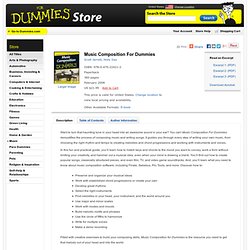
You can! Music Composition For Dummies demystifies the process of composing music and writing songs. It guides you through every step of writing your own music, from choosing the right rhythm and tempo to creating melodies and chord progressions and working with instruments and voices. In this fun and practical guide, you’ll learn how to match keys and chords to the mood you want to convey, work a form without limiting your creativity, and hammer out a musical idea, even when your mind is drawing a blank. You’ll find out how to create popular songs, classically structured pieces, and even film, TV, and video game soundtracks. Music & Creative Arts - How-To Help and Videos. How to Read the Key Signature to Determine What Key to Play.
Knowing how to read the key signature to determine what key to play is critical to reading music, but it isn't difficult.

How to Read Key Signatures. Key signatures are important when reading music.
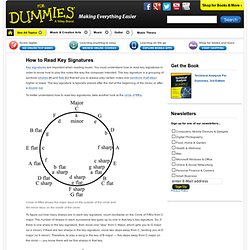
You must understand how to read key signatures in order to know how to play the notes the way the composer intended. The key signature is a grouping of symbols (sharps [#] and flats [b]) that tell you to always play certain notes one semitone (half-step) higher or lower. How Musical Notes Are Constructed. You couldn't read or write music without notes.

If you think of music as a language, the notes are like letters of the alphabet. If you know how to recognize the notes, you can learn the language. Notes are made up of up to three specific components: note head, stem, and flag. Every note has a head — it’s the round part of a note. A note stem is the vertical line attached to the note head. Every note has a head. How to Recognize the Beat in Music. Recognizing the beat in a song means finding the pattern and speed of the music.
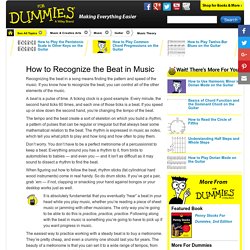
If you know how to recognize the beat, you can control all of the other elements of the music. A beat is a pulse of time. How to Read the Circle of Fifths. Music Theory - Intervals & Scales. As of July 1, 2013 ThinkQuest has been discontinued.

We would like to thank everyone for being a part of the ThinkQuest global community: Students - For your limitless creativity and innovation, which inspires us all. Teachers - For your passion in guiding students on their quest. Partners - For your unwavering support and evangelism. Parents - For supporting the use of technology not only as an instrument of learning, but as a means of creating knowledge. Ricci Adams' Musictheory.net. Emancipation of the dissonance. Chords, featuring chromatically altered sevenths and ninths and progressing unconventionally, explored by Debussy in a "celebrated conversation at the piano with his teacher Ernest Guiraud" (Lockspeiser 1962, 207).

The emancipation of the dissonance was a concept or goal put forth by composer Arnold Schoenberg and others, including his pupil Anton Webern. The phrase first appears in Schoenberg's 1926 essay "Opinion or Insight? " (Schoenberg 1975, 258–64). It may be described as a metanarrative to justify atonality. Jim Samson (1977, 146–47) describes: Consonance & Dissonance. Consonance[edit] The definition of consonance has been variously based on experience, frequency, and both physical and psychological considerations (Myers 1904, p. 315).
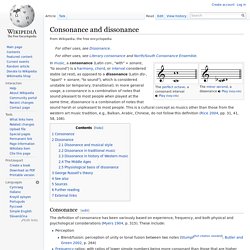
These include: Perception Blend/fusion: perception of unity or tonal fusion between two notes (Stumpf[full citation needed]; Butler and Green 2002, p. 264)Frequency ratios: with ratios of lower simple numbers being more consonant than those that are higher (Pythagoras[full citation needed]). Many of these definitions do not require exact integer tunings, only approximation. [vague][citation needed]Both Continuity: consonances are continuous and dissonances are intermittent in sensation, determined by coincidence of partials (Helmholtz 1954 [1877],[page needed]).
These may be generalized as simplicity. Medieval music. Medieval music is Western music written during the Middle Ages.
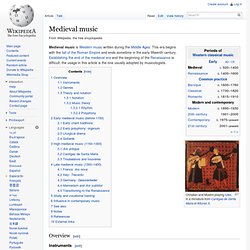
This era begins with the fall of the Roman Empire and ends sometime in the early fifteenth century. Establishing the end of the medieval era and the beginning of the Renaissance is difficult; the usage in this article is the one usually adopted by musicologists. Overview[edit] Harmonic Limit. The first 16 harmonics, with frequencies and log frequencies. Overtone series, partials 1-5 numbered Play . In just intonation, intervals between pitches are drawn from the rational numbers. Binaural beats. Binaural beats To experience the binaural beats perception, it is best to listen to this file with headphones on moderate to weak volume – the sound should be easily heard, but not loud.
Note that the sound appears to pulsate. Now remove one earphone. Note that the pulsations disappear completely. Repeat with your other ear. The brain produces a phenomenon resulting in low-frequency pulsations in the amplitude and sound localization of a perceived sound when two tones at slightly different frequencies are presented separately, one to each of a subject's ears, using stereo headphones. Binaural beats reportedly influence the brain in more subtle ways through the entrainment of brainwaves[3][8][9] and provide other health benefits such as control over pain.[10][11] Octave. The octave has occasionally been referred to as a diapason.[2] Theory[edit] Pitch class. All Cs possible on a piano (except C8, available on grand) Play . Circle of fifths. Circle of fifths showing major and minor keys Nikolay Diletsky's circle of fifths in Idea grammatiki musikiyskoy (Moscow, 1679)
Major scale. Major scales C major scale ) Structure[edit] Musical scale. Pattern of intervals in the C-major scale Play. Scale (music) When we make tunes, we use musical notes of different pitches: some high and some low. A scale can be referred to as a series of notes, in order, going up or down in pitch. On a piano, there are white keys and black keys.